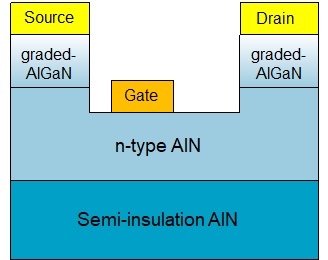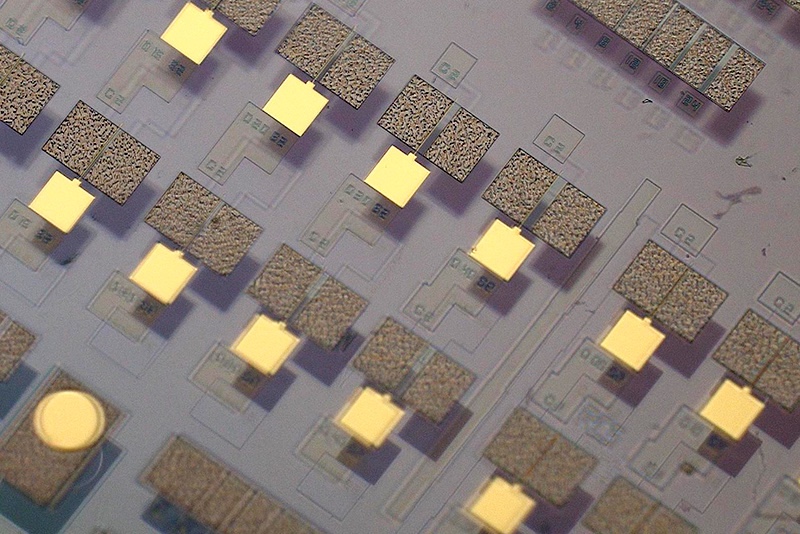


NTT:世界初、窒化アルミパワー半導体:
Semi-con de puissance en nitrure d’aluminium :
Aluminiumnitrid-Leistungshalbleiter:
Aluminum nitride power semicon:
氮化鋁功率半導體:
ー世界初の窒化アルミ電界効果トランジスター
NTT物性科学基礎研究所:
窒化アルミニウムの電界効果トランジスタを開発した。
絶縁破壊電圧は1700ボルトと大きく、
500度Cの電流値は100万倍に及ぶ、オンオフ比を実現した。
窒化アルミのトランジスタ動作:
耐熱性が高く、高温下でも冷却なしで稼働できる。
窒化アルミでのトランジスタ動作は世界初だ。
高温高耐圧のパワー半導体の開発につながる。
ニュースイッチ
NTT : Semi-conducteur de puissance en nitrure d’aluminium :
-Le premier transistor à effet de champ en nitrure d’aluminium au monde
NTT Busseikagaku Kenkyusho :
Nous avons développé un transistor à effet de champ en nitrure d’aluminium.
La tension de claquage est aussi grande que 1700 volts,
La valeur actuelle de 500 degrés Celsius a atteint un rapport marche / arrêt de 1 million de fois.
Fonctionnement du transistor en nitrure d’aluminium :
Il a une résistance élevée à la chaleur et peut fonctionner sans refroidissement même à des températures élevées.
Le fonctionnement du transistor avec du nitrure d’aluminium est le premier au monde.
Cela conduira au développement de semi-conducteurs de puissance à haute température et à haute tension de tenue.
Nouvel interrupteur
NTT: Aluminiumnitrid-Leistungshalbleiter:
-Der weltweit erste Aluminiumnitrid-Feldeffekttransistor
NTT Busseikagaku Kenkyusho:
Wir haben einen Feldeffekttransistor aus Aluminiumnitrid entwickelt.
Die Durchbruchspannung beträgt bis zu 1700 Volt,
Der aktuelle Wert von 500 Grad Celsius hat ein Ein / Aus-Verhältnis von 1 Million Mal erreicht.
Betrieb des Aluminiumnitrid-Transistors:
Es hat eine hohe Hitzebeständigkeit und kann auch bei hohen Temperaturen ohne Kühlung betrieben werden.
Der Transistorbetrieb mit Aluminiumnitrid ist weltweit der erste.
Dies wird zur Entwicklung von Hochtemperatur- und Hochspannungs-Leistungshalbleitern führen.
Neuer Schalter
The world’s first demonstration of aluminum nitride transistor Advancing toward next-generation power devices contributing to carbon neutrality
April 22, 2022
NTT Corporation (TYO: 9432), today, announces that it has achieved transistor1 operation using high-quality aluminum nitride (AlN).
Transistors, which are an essential component of semiconductor power devices2,
are used for power conversion in home electronics and electric vehicles, and their improved efficiency will contribute to energy saving.
AlN for ultra-wide bandgap (UWBG) semiconductors3
has a large breakdown field and is therefore a promising semiconductor material for achieving low-loss, high-voltage power devices.
NTT has successfully produced
high-quality AlN by using metalorganic chemical vapor deposition (MOCVD)4and also developed formation methods of ohmic5 and Schottky6 contacts.
These technologies allowed us
to demonstrate AlN transistors for the first time.Furthermore,
even at the high temperature of 500°C,
the AlN transistors showed good device characteristics.These results will contribute to realization of ultra-low-loss power devices and high-temperature electronics.
Results
NTT succeeded for the first time in transistor operation
with good characteristics using a high-quality semiconducting AlN fabricated by MOCVD.
The current-voltage characteristics of the AlN transistors
showed good ohmic characteristics (Fig. 2 and 3) and an extremely small leakage current.
The breakdown voltage was as large as 1.7 kV.
We also confirmed
that the AlN transistor can operate stably at high temperatures (Fig. 4).In contrast to conventional semiconductor materials,
AlN transistors showed improved performance at high temperatures.
The drain current increased
to about 100 times as ambient temperature increased from room temperature to 500°C.Moreover, even at 500°C,
the leakage current was kept extremely low at 10-8 A/mm.As a result, a high drain current on/off ratio of 106 was obtained at 500°C.
Press Release | NTT Tokyo